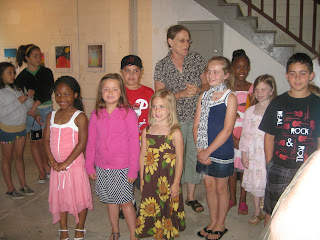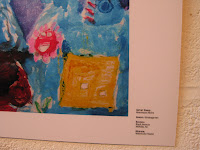





My Special Fathers’ Day gift, from daughter!
By Azubike Aliche
Although my kids made drawings/paintings and bought cards for me this Fathers’ Day, the special gift came from my six-year-old daughter, Nnenna! At the Perkins Center for the Arts, in Collingswood, New Jersey, yesterday, I really felt proud, as a father. The center organized a reception in honor of Nnenna and 34 other students from five states (Delaware, Virginia, New Jersey, Pennsylvania, Sesebo City) in the US, Japan, Taiwan and Singapore. It is the ninth edition of “Young Voices, Horseshoe Crab and the Arts,” designed “to bring attention to the horseshoe crab and encourage individuals to assist and appreciate this remarkable creatures.” The 2009 Horseshoe Crabs and the Arts contest is meant for students in grades Pre-K – 12. As part of the reception, the center mounted an exhibition tagged Young Voices, featuring the art works of these students. The selected artworks are, also, to appear in the Ecological Research and Development Group’s anthology, Poems, Tales and Images, 2009. Apart from the book version, this publication will also be available on the Web at www.horseshoecrab.org. From over 400 entries, the Board of Directors of the Ecological Research and Development Group had judged Nnenna’s work to be outstanding enough to make it in their annual publication. They helped made my Fathers’ Day special, this year! Nnenna entered for the competition in her kindergarten class, even as some others entered from as much as the 11th grade. See accompanying photos.
The Ecological Research and Development Group, ERDG, otherwise called the Horseshoe Crab Guys, is a non-profit organization whose main goal is the protection of the world’s four remaining horseshoe crab species. The organization pursues its goals through scientific research, education, and environmental planning and management. Among others, it provides the educational foundation for a meaningful understanding of this remarkable specie and its conservation needs. The annual arts contests for students and other in-school programs are some of the many activities that the ERDG is engaged in.
Of the four species of the horseshoe crab, the Atlantic Horseshoe crab, found along the eastern coast of North and Central America, is the most numerous and accounts for the largest percentage of the worldwide horseshoe crab population. It is found in great numbers in the Delaware Bay, around where we live. To quote from an ERDG publication: “ The miles of sandy, wave-protected beaches in the bay offers optimal conditions for spawning and the tidal flats provide ideal habitat for juvenile crab growth and development.”
Incorporated in 1977, the Perkins Center for the Arts has locations in Moorestown and Collingswood, serving residents in southern New Jersey and beyond, by providing high quality art programs in grassroots settings. The center says that it is dedicated to excellence in the arts and to providing a wide range of creative opportunities for people of all ages and of every level of artistic development. It provides art studios, classrooms and exhibition spaces, among others, for its programs in visual arts, performing and literary arts.
By Azubike Aliche
Although my kids made drawings/paintings and bought cards for me this Fathers’ Day, the special gift came from my six-year-old daughter, Nnenna! At the Perkins Center for the Arts, in Collingswood, New Jersey, yesterday, I really felt proud, as a father. The center organized a reception in honor of Nnenna and 34 other students from five states (Delaware, Virginia, New Jersey, Pennsylvania, Sesebo City) in the US, Japan, Taiwan and Singapore. It is the ninth edition of “Young Voices, Horseshoe Crab and the Arts,” designed “to bring attention to the horseshoe crab and encourage individuals to assist and appreciate this remarkable creatures.” The 2009 Horseshoe Crabs and the Arts contest is meant for students in grades Pre-K – 12. As part of the reception, the center mounted an exhibition tagged Young Voices, featuring the art works of these students. The selected artworks are, also, to appear in the Ecological Research and Development Group’s anthology, Poems, Tales and Images, 2009. Apart from the book version, this publication will also be available on the Web at www.horseshoecrab.org. From over 400 entries, the Board of Directors of the Ecological Research and Development Group had judged Nnenna’s work to be outstanding enough to make it in their annual publication. They helped made my Fathers’ Day special, this year! Nnenna entered for the competition in her kindergarten class, even as some others entered from as much as the 11th grade. See accompanying photos.
The Ecological Research and Development Group, ERDG, otherwise called the Horseshoe Crab Guys, is a non-profit organization whose main goal is the protection of the world’s four remaining horseshoe crab species. The organization pursues its goals through scientific research, education, and environmental planning and management. Among others, it provides the educational foundation for a meaningful understanding of this remarkable specie and its conservation needs. The annual arts contests for students and other in-school programs are some of the many activities that the ERDG is engaged in.
Of the four species of the horseshoe crab, the Atlantic Horseshoe crab, found along the eastern coast of North and Central America, is the most numerous and accounts for the largest percentage of the worldwide horseshoe crab population. It is found in great numbers in the Delaware Bay, around where we live. To quote from an ERDG publication: “ The miles of sandy, wave-protected beaches in the bay offers optimal conditions for spawning and the tidal flats provide ideal habitat for juvenile crab growth and development.”
Incorporated in 1977, the Perkins Center for the Arts has locations in Moorestown and Collingswood, serving residents in southern New Jersey and beyond, by providing high quality art programs in grassroots settings. The center says that it is dedicated to excellence in the arts and to providing a wide range of creative opportunities for people of all ages and of every level of artistic development. It provides art studios, classrooms and exhibition spaces, among others, for its programs in visual arts, performing and literary arts.
























